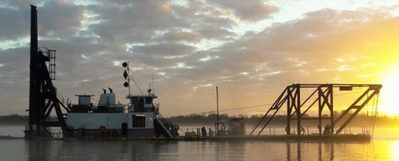
WB Wood (Photo: Wood Resources)
A company’s lack of requirements for crew to regularly check below-deck compartments led to undetected flooding and the eventual capsizing of a dredging vessel last year on the Mississippi River, the National Transportation Safety Board (NTSB) said Thursday.
Wood Resources’ owned and operated non-propelled dredging vessel WB Wood capsized on the early morning of Jan. 16, 2023, during dredging operations. Before the capsizing, the dredge had been in the same location for nine days, pumping sand from the riverbed to a pit on the west bank. An estimated 5,500 gallons of oil were released, and the vessel was declared a total loss of $1.5 million. No injuries were reported.
About two hours before the capsizing, the dredge’s leverman noticed the dredge listing abnormally to starboard. The leverman discovered a starboard storage space full of water and began using a portable pump to dewater the space. The onboard portable pump and a second pump later added could not keep up with the rate of flooding and the starboard list continued to increase.
During a post-salvage examination, investigators found a through-hull pipe into the starboard storage space was open and its overboard check valve was missing. Investigators determined the initial starboard list was likely caused by flooding through the unsecured through-hull pipe into the starboard storage space. Progressive flooding through comprised watertight bulkheads within the hull further increased the starboard list and aft trim which led to the capsizing of the vessel.
Two days before the capsizing, the day leverman discovered water in the starboard storage space, but was not able to identify the source of the water. In the time leading up to the capsizing, the crew did not know if any hull compartments had leaks or water in them. The company did not have requirements for regularly checking compartments below deck, which resulted in the undetected flooding.
“Vessel crews should regularly check tanks and voids that are adjacent to the vessel’s hull to identify hull integrity issues,” the report said. “The presence of water can indicate an issue with watertight integrity or wastage and should be addressed. Vessel operators should ensure crews have procedures for anticipating, preventing, and addressing the potential for water ingress and flooding, including establishing scheduled checks. Bilge alarms set to detect water at a low level in voids and other spaces are another means to ensure early detection.”





